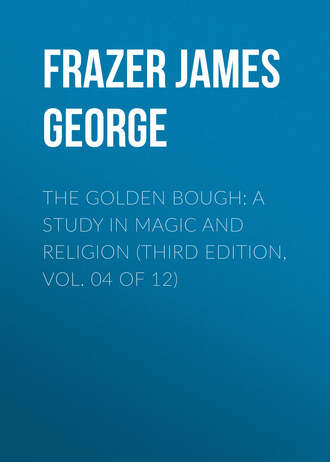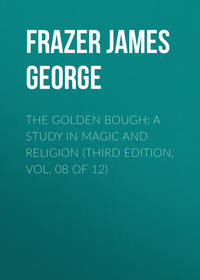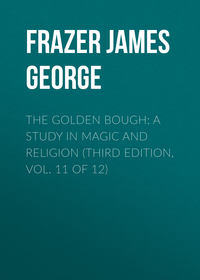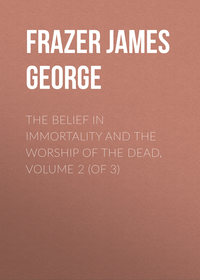 полная версия
полная версияThe Golden Bough: A Study in Magic and Religion (Third Edition, Vol. 04 of 12)
420
Lasicius, “De diis Samagitarum caeterorumque Sarmatarum,” in Respublica sive status regni Poloniae, Lituaniae, Prussiae, Livoniae, etc. (Elzevir, 1627), pp. 306 sq.; id., edited by W. Mannhardt in Magazin herausgegeben von der Lettisch-Literarischen Gesellschaft, xiv. 91 sq.; J. G. Kohl, Die deutsch-russischen Ostseeprovinzen (Dresden and Leipsic, 1841), ii. 27. There, are, however, other occasions when superstition requires a person to stand on one foot. At Toku-toku, in Fiji, the grave-digger who turns the first sod has to stand on one leg, leaning on his digging-stick (Rev. Lorimer Fison, in a letter to the author, dated August 26, 1898). Among the Angoni of British Central Africa, when the corpse of a chief is being burned, his heir stands beside the blazing pyre on one leg with his shield in his hand; and three days later he again stands on one leg before the assembled people when they proclaim him chief. See R. Sutherland Rattray, Some Folk-lore Stories and Songs in Chinyanja (London, 1907), pp. 100, 101.
421
E. Young, The Kingdom of the Yellow Robe, p. 212.
422
J. G. Kohl, Die deutsch-russischen Ostseeprovinzen, ii. 25. With regard to swinging as a magical or religious rite, see Note B at the end of the volume. For other charms to make the crops grow tall by leaping, letting the hair hang loose, and so forth, see The Magic Art and the Evolution of Kings, i. 135 sqq.
423
Macrobius, Saturn. v. 19. 13.
424
See Taboo and the Perils of the Soul, pp. 225 sqq.
425
Sir John Malcolm, History of Persia (London, 1815), i. 527 sq. I am indebted to my friend Mr. W. Crooke for calling my attention to this passage.
426
Captain John Stevens, The History of Persia (London, 1715), pp. 356 sq. I have to thank Mr. W. Crooke for his kindness in copying out this passage and sending it to me. I have not seen the original. An Irish legend relates how the abbot Eimine Ban and forty-nine of his monks sacrificed themselves by a voluntary death to save Bran úa Faeláin, King of Leinster, and forty-nine Leinster chiefs, from a pestilence which was then desolating Leinster. They were sacrificed in batches of seven a day for a week, the abbot himself perishing after the last batch on the last day of the week. But it is not said that the abbot enjoyed regal dignity during the seven days. See C. Plummer, “Cáin Eimíne Báin,” Ériu, the Journal of the School of Irish Learning, Dublin. vol. iv. part i. (1908) pp. 39-46. The legend was pointed out to me by Professor Kuno Meyer.
427
“Ynglinga Saga,” 29, in The Heimskringla or Chronicle of the Kings of Norway, translated from the Icelandic of Snorro Sturleson, by S. Laing (London, 1844), i. 239 sq.; H. M. Chadwick, The Cult of Othin (London, 1899), pp. 4, 27. I have already cited the tradition as evidence of a nine years' tenure of the kingship in Sweden. See above, p. 57, with note 2.
428
Herodotus, vii. 197; Apollodorus, i. 9. 1 sq.; Schol. on Aristophanes, Clouds, 257; J. Tzetzes, Schol. on Lycophron, 21, 229; Schol. on Apollonius Rhodius, Argonautica, ii. 653; Eustathius, on Homer, Iliad, vii. 86, p. 667; id., on Odyssey, v. 339, p. 1543; Pausanias, i. 44. 7, ix. 34. 7; Zenobius, iv. 38; Plutarch, De superstitione, 5; Hyginus, Fab. 1-5; id., Astronomica, ii. 20; Servius, on Virgil, Aen. v. 241. The story is told or alluded to by these writers with some variations of detail. In piecing their accounts together I have chosen the features which seemed to be the most archaic. According to Pherecydes, one of the oldest writers on Greek legendary history, Phrixus offered himself as a voluntary victim when the crops were perishing (Schol. on Pindar, Pyth. iv. 288). On the whole subject see K. O. Müller, Orchomenus und die Minyer,2 pp. 156, 171.
429
Plato, Minos, p. 315 c.
430
Plutarch, Quaest. Graec. 38; Antoninus Liberalis, Transform. 10; Ovid, Metam. iv. 1 sqq.
431
Pausanias, ix. 34. 5 sqq.; Apollonius Rhodius, Argonautica, iii. 265 sq.; Hellanicus, cited by the Scholiast on Apollonius, l. c. Apollodorus speaks of Athamas as reigning over Boeotia (Bibliotheca, i. 9. 1); Tzetzes calls him king of Thebes (Schol. on Lycophron, 21).
432
The old Scholiast on Apollonius Rhodius (Argon. ii. 653) tells us that down to his time it was customary for one of the descendants of Athamas to enter the town-hall and sacrifice to Laphystian Zeus. K. O. Müller sees in this custom a mitigation of the ancient rule – instead of being themselves sacrificed, the scions of royalty were now permitted to offer sacrifice (Orchomenus und die Minyer,2 p. 158). But this need not have been so. The obligation to serve as victims in certain circumstances lay only on the eldest male of each generation in the direct line; the sacrificers may have been younger brothers or more remote relations of the destined victims. It may be observed that in a dynasty of which the eldest males were regularly sacrificed, the kings, if they were not themselves the victims, must always have been younger sons.
433
See The Magic Art and the Evolution of Kings, vol. i. p. 310.
434
I have followed K. O. Müller (Orchomenus und die Minyer,2 pp. 160, 166 sq.) in regarding the ram which saved Phrixus as a mythical expression for the substitution of a ram for a human victim. He points out that a ram was the proper victim to sacrifice to Trophonius (Pausanias, ix. 39. 6), whose very ancient worship was practised at Lebadea not far from Orchomenus. The principle of vicarious sacrifices was familiar enough to the Greeks, as K. O. Müller does not fail to indicate. At Potniae, near Thebes, goats were substituted as victims instead of boys in the sacrifices offered to Dionysus (Pausanias, ix. 8. 2). Once when an oracle commanded that a girl should be sacrificed to Munychian Artemis in order to stay a plague or famine, a goat dressed up as a girl was sacrificed instead (Eustathius on Homer, Iliad, ii. 732, p. 331; Apostolius, vii. 10; Paroemiogr. Graeci, ed. Leutsch et Schneidewin, ii. 402; Suidas, s. v. Ἔμβαρος). At Salamis in Cyprus a man was annually sacrificed to Aphrodite and afterwards to Diomede, but in later times an ox was substituted (Porphyry, De abstinentia, ii. 54). At Laodicea in Syria a deer took the place of a maiden as the victim yearly offered to Athena (Porphyry, op. cit. ii. 56). Since human sacrifices have been forbidden by the Dutch Government in Borneo, the Barito and other Dyak tribes of that island have kept cattle for the sole purpose of sacrificing them instead of human beings at the close of mourning and at other religious ceremonies. See A. W. Nieuwenhuis, Quer durch Borneo, ii. (Leyden, 1907), p. 127.
435
Philo of Byblus, quoted by Eusebius, Praeparatio Evangelii, i. 10. 29 sq.
436
2 Kings iii. 27.
437
On this subject see Dr. G. F. Moore, s. v. “Molech, Moloch,” Encyclopaedia Biblica, iii. 3183 sqq.; C. P. Tiele, Geschichte der Religion im Altertum, i. (Gotha, 1896) pp. 240-244.
438
Porphyry, De abstinentia, ii. 56.
439
Plato, Minos, p. 315 c.
440
Plutarch, Regum et imperatorum apophthegmata, Gelon I.
441
Diodorus Siculus, xx. 14. Compare Clitarchus, cited by Suidas, s. v. σαρδάνιος γέλως, and by the Scholiast on Plato, Republic, p. 337 a; J. Selden, De dis Syris (Leipsic, 1668), pp. 169 sq.
442
Plutarch, De superstitione, 13. Egyptian mothers were glad and proud when their children were devoured by the holy crocodiles. See Aelian, De natura animalium, x. 21; Maximus Tyrius, Dissert. viii. 5; Josephus, Contra Apion. ii. 7.
443
Tertullian, Apologeticus, 6. Compare Justin, xviii. 6. 12; Ennius, cited by Festus, s. v. “Puelli,” pp. 248, 249, ed. C. O. Müller; Augustine, De civitate Dei, vii. 19 and 26.
444
“Every abomination to the Lord, which he hateth, have they done unto their gods; for even their sons and their daughters do they burn in the fire to their gods,” Deuteronomy xii. 31. Here and in what follows I quote the Revised English Version.
445
Deuteronomy xviii. 9-12.
446
Leviticus xviii. 21.
447
Psalms cvi. 35-38.
448
2 Kings xvii. 16, 17.
449
“And they have built the high places of Topheth, which is in the valley of the son of Hinnom, to burn their sons and their daughters in the fire,” Jeremiah vii. 31; “And have built the high places of Baal, to burn their sons in the fire for burnt offerings unto Baal,” id. xix. 5; “And they built the high places of Baal, which are in the valley of the son of Hinnom, to cause their sons and their daughters to pass through the fire unto Molech,” id. xxxii. 35; “Moreover thou hast taken thy sons and thy daughters, whom thou hast borne unto me, and these hast thou sacrificed unto them to be devoured. Were thy whoredoms a small matter, that thou hast slain my children, and delivered them up, in causing them to pass through the fire unto them?” Ezekiel xvi. 20 sq.; compare xx. 26, 31. A comparison of these passages shews that the expression “to cause to pass through the fire,” so often employed in this connexion in Scripture, meant to burn the children in the fire. Some have attempted to interpret the words in a milder sense. See J. Spencer, De legibus Hebraeorum (The Hague, 1686), i. 288 sqq.
450
2 Chronicles xxviii. 3. In the corresponding passage of 2 Kings (xvi. 3) it is said that Ahaz “made his son to pass through the fire.”
451
2 Chronicles xxxiii. 6; compare 2 Kings xxi. 6.
452
2 Kings xxiii. 10.
453
Jerome on Jeremiah vii. 31, quoted in Winer's Biblisches Realwôrterbuch,2 s. v. “Thopeth.”
454
The Tel El-Amarna tablets prove that “the prae-Israelitish inhabitants of Canaan were closely akin to the Hebrews, and that they spoke substantially the same language” (S. R. Driver, in Authority and Archaeology, Sacred and Profane, edited by D. G. Hogarth (London, 1899), p. 76).
455
2 Kings xvii. 31. The identification of Sepharvaim is uncertain. See Encyclopaedia Biblica, iv. 4371 sq.
456
Micah vi. 6-8.
457
Ezekiel xx. 25, 26, 31.
458
Exodus xiii. 1 sq.
459
Exodus xiii. 12.
460
Exodus xxxiv. 19. In the Authorised Version the passage runs thus: “All that openeth the matrix is mine; and every firstling among thy cattle, whether ox or sheep, that is male.”
461
Exodus xxii. 29 sq. The Authorised Version has “the first of thy ripe fruits" instead of "the abundance of thy fruits.”
462
Numbers xviii. 17 sq. Elsewhere, however, we read: “All the firstling males that are born of thy herd and of thy flock thou shalt sanctify unto the Lord thy God: thou shalt do no work with the firstling of thine ox, nor shear the firstling of thy flock. Thou shalt eat it before the Lord thy God year by year in the place which the Lord shall choose, thou and thy household,” Deuteronomy xv. 19 sq. Compare Deuteronomy xii. 6 sq., 17 sq. To reconcile this ordinance with the other we must suppose that the flesh was divided between the Levite and the owner of the animal. But perhaps the rule in Deuteronomy may represent the old custom which obtained before the rise of the priestly caste. Prof. S. R. Driver inclines to the latter view (Commentary on Deuteronomy, p. 187).
463
Exodus xiii. 13, xxxiv. 20.
464
Numbers xviii. 15 sq. Compare Numbers iii. 46-51; Exodus xiii. 13, xxxiv. 20.
465
Exodus xi. – xiii. 16; Numbers iii. 13, viii. 17. While many points in this strange story remain obscure, the reason which moved the Israelites of old to splash the blood of lambs on the doorposts of their houses at the Passover may perhaps have been not very different from that which induces the Sea Dyaks of Borneo to do much the same thing at the present day. “When there is any great epidemic in the country – when cholera or smallpox is killing its hundreds on all sides – one often notices little offerings of food hung on the walls and from the ceiling, animals killed in sacrifice, and blood splashed on the posts of the houses. When one asks why all this is done, they say they do it in the hope that when the evil spirit, who is thirsting for human lives, comes along and sees the offerings they have made and the animals killed in sacrifice, he will be satisfied with these things, and not take the lives of any of the people living in the Dyak village house” (E. H. Gomes, Seventeen Years among the Sea Dyaks of Borneo, London, 1911, p. 201). Similarly in Western Africa, when a pestilence or an attack of enemies is expected, it is customary to sacrifice sheep and goats and smear their blood on the gateways of the village (Miss Mary H. Kingsley, Travels in West Africa, p. 454, compare p. 45). In Peru, when an Indian hut is cleansed and whitewashed, the blood of a llama is always sprinkled on the doorway and internal walls in order to keep out the evil spirit (Col. Church, cited by E. J. Payne, History of the New World called America, i. 394, note 2). For more evidence of the custom of pouring or smearing blood on the threshold, lintel, and side-posts of doors, see Ph. Paulitschke, Ethnographie Nordost-Afrikas, die geistige Cultur der Danâkil, Galla und Somâl (Berlin, 1896), pp. 38, 48; J. Goldziher, Muhamedanische Studien, ii. 329; S. J. Curtiss, Primitive Semitic Religion To-day, pp. 181-193, 227 sq.; H. C. Trumbull, The Threshold Covenant (New York, 1896), pp. 4 sq., 8 sq., 26-28, 66-68. Perhaps the original intention of the custom was to avert evil influence, especially evil spirits, from the door.
466
Genesis xxii. 1-13.
467
See for example Father Baudin, in Missions Catholiques, xvi. (1894) p. 333; A. B. Ellis, The Yoruba-speaking Peoples of the Slave Coast, pp. 105 sq.
468
W. E. Maxwell, “The Folklore of the Malays,” Journal of the Straits Branch of the Royal Asiatic Society, No. 7 (June 1881), p. 14; W. W. Skeat, Malay Magic, p. 112. The bird in question is thought to be the goat-sucker or night-jar.
469
2 Kings iii. 27.
470
See above, pp. 166, 167.
471
As to the redemption of the firstborn among modern Jews, see L. Löw, Die Lebensalter in der jüdischen Literatur (Szegedin, 1875), pp. 110-118; Budgett Meakin, The Moors (London, 1902), pp. 440 sq.
472
J. Wellhausen, Prolegomena zur Geschichte Israels,3 p. 90; W. Robertson Smith, Religion of the Semites,2 p. 464. On the other hand, when I published the foregoing discussion in the second edition of my book, I was not aware that the conclusion reached in it had been anticipated by Prof. Th. Nöldeke, who has drawn the same inference from the same evidence. See Zeitschrift der Deutschen Morgenländischen Gesellschaft, xlii. (1888) p. 483. I am happy to find myself in agreement with so eminent an authority on Semitic antiquity.
473
R. Brough Smyth, Aborigines of Victoria, ii. 311. In the Luritcha tribe of central Australia “young children are sometimes killed and eaten, and it is not an infrequent custom, when a child is in weak health, to kill a younger and healthy one and then to feed the weakling on its flesh, the idea being that this will give the weak child the strength of the stronger one” (Spencer and Gillen, Native Tribes of Central Australia, p. 475). The practice seems to have been common among the Australian aborigines. See W. E. Stanbridge, quoted by R. Brough Smyth, op. cit. i. 52; A. W. Howitt, Native Tribes of South-East Australia, pp. 749, 750.
474
G. Scriviner, in E. Curr's The Australian Race, ii. 182.
475
A. W. Howitt, Native Tribes of South-East Australia, p. 750.
476
S. Gason, in E. Curr's The Australian Race, ii. 119.
477
Father Mazzuconi, in Annales de la Propagation de la Foi, xxvii. (1855) pp. 368 sq.
478
J. J. M. de Groot, Religious System of China, ii. 679, iv. 364.
479
J. J. M. de Groot, op. cit. iv. 365. On these Chinese reports Prof. de Groot remarks (op. cit. iv. 366): “Quite at a loss, however, we are to explain that eating of firstborn sons by their own nearest kinsfolk, absolutely inconsistent as it is with a primary law of tribal life in general, which imperiously demands that the tribe should make itself strong in male cognates, but not indulge in self-destruction by killing its natural defenders. We feel, therefore, strongly inclined to believe the statement fabulous.” Such scepticism implies an opinion of the good sense and foresight of savages which is far from being justified by the facts. Many savage tribes have “indulged in self-destruction” by killing a large proportion of their children, both male and female. See below, pp. 196 sq.
480
W. Crooke, Popular Religion and Folklore of Northern India, ii. 169.
481
H. A. Rose, “Unlucky Children,” Folklore, xiii. (1902) p. 63; id., in Indian Antiquary, xxxi. (1902) pp. 162 sq. Mr. Rose is Superintendent of Ethnography in the Punjaub. The authorities cited by him are Moore's Hindu Infanticide, pp. 198 sq., and Sherring's Hindu Tribes and Castes, iii. p. 66.
482
Captain Philip Maud, “Exploration in the Southern Borderland of Abyssinia,” The Geographical Journal, xxiii. (1904) pp. 567 sq.
483
Exodus iv. 24-26.
484
Captain C. H. Stigand, To Abyssinia through an Unknown Land (London, 1910), pp. 234 sq.
485
J. Roscoe, “Further Notes on the Manners and Customs of the Baganda,” Journal of the Anthropological Institute, xxxii. (1902) p. 30. Mr. Roscoe informs me that a similar custom prevails also in Koki and Bunyoro.
486
J. L. Krapf, Travels, Researches, and Missionary Labours during an Eighteen Years' Residence in Eastern Africa (London, 1860), pp. 69 sq. Dr. Krapf, who reports the custom at second hand, thinks that the existence of the pillar may be doubted, but that the rest of the story harmonises well enough with African superstition.
487
J. Macdonald, Light in Africa2 (London, 1890), p. 156. In the text I have embodied some fuller explanations and particulars which my friend the Rev. Mr. Macdonald was good enough to send me in a letter dated September 16th, 1899. Among the tribes with which Mr. Macdonald is best acquainted the custom is obsolete and lives only in tradition; formerly it was universally practised.
488
F. J. Mone, Geschichte des Heidenthums im nördlichen Europa (Leipsic and Darmstadt, 1822-1823), i. 119.
489
Vallancey, Collectanea de rebus Hibernicis, vol. iii. (Dublin, 1786) p. 457; D. Nutt, The Voyage of Bran, ii. 149-151, 304 sq.; P. W. Joyce, Social History of Ancient Ireland, i. 275 sq., 281-284. The authority for the tradition is the Dinnschenchas or Dinnsenchus, a document compiled in the eleventh and twelfth centuries out of older materials. Mr. Joyce discredits the tradition of human sacrifice.
490
Fr. Boas, in “Fourth Annual Report on the North-Western Tribes of Canada,” Report of the British Association for 1888, p. 242; id., in Fifth Report on the North-Western Tribes of Canada, p. 52 (separate reprint from the Report of the British Association for 1889).
491
Fr. Boas, in Fifth Report on the North-Western Tribes of Canada, p. 46 (separate reprint from the Report of the British Association for 1889).
492
W. Strachey, Historie of travaile into Virginia Britannia (Hakluyt Society, London, 1849), p. 84.
493
J. Bricknell, The Natural History of North Carolina (Dublin, 1737), pp. 342 sq. I have taken the liberty of altering slightly the writer's somewhat eccentric punctuation.
494
See above, p. 162.
495
A. de Herrera, The General History of the Vast Continent and Islands of America, translated by Capt. John Stevens (London, 1725-6), iv. 347 sq. Compare J. de Acosta, Natural and Moral History of the Indies (Hakluyt Society, London, 1880), ii. 344.
496
Fr. Xeres, Relation véridique de la conquête du Perou et de la Province de Cuzco nommée Nouvelle-Castille (in H. Ternaux-Compans's Voyages, relations et mémoires, etc., Paris, 1837), p. 53.
497
Juan de Velasco, Histoire du royaume de Quito, i. (Paris, 1840) p. 106 (forming vol. xviii. of H. Ternaux-Compans's Voyages, relations et mémoires, etc.).
498
A. R. Wallace, Narrative of Travels on the Amazon and Rio Negro (London, 1889), p. 355.
499
W. Barbrooke Grubb, An Unknown People in an Unknown Land (London, 1911), p. 233.
500
Festus, De verborum significatione, s. vv. “Mamertini,” “Sacrani,” and “Ver sacrum,” pp. 158, 370, 371, 379, ed. C. O. Müller; Servius on Virgil, Aen. vii. 796; Nonius Marcellus, s. v. “ver sacrum,” p. 522 (p. 610, ed. Quicherat); Varro, Rerum rusticarum, iii. 16. 29; Dionysius Halicarnasensis, Antiquit. Rom. i. 16 and 23 sq., ii. 1. 2.
501
Strabo, v. 4. 2 and 12; Pliny, Nat. hist. iii. 110; Festus, De verborum significatione, s. v. “Irpini,” ed. C. O. Müller, p. 106. It is worthy of note that the three swarms which afterwards developed into the Piceni, the Samnites, and the Hirpini were said to have been guided by a woodpecker, a bull, and a wolf respectively, of which the woodpecker (picus) and the wolf (hirpus) gave their names to the Piceni and the Hirpini. The tradition may perhaps preserve a trace of totemism, but in the absence of clearer evidence it would be rash to assume that it does so. The woodpecker was sacred among the Latins, and a woodpecker as well as a wolf is said to have fed the twins Romulus and Remus (Plutarch, Quaest. Rom. 21; Ovid, Fasti, iii. 37 sq.). Does this legend point to the existence of a wolf-clan and a woodpecker-clan at Rome? There was perhaps a similar conjunction of wolf and woodpecker at Soracte, for the woodpecker is spoken of as the bird of Feronia (“picus Feronius,” Festus, s. v. “Oscines,” p. 197, ed. C. O. Müller), a goddess in whose sanctuary at Soracte certain men went by the name of Soranian Wolves (Servius, on Virgil, Aen. xi. 785; Pliny, Nat. hist. vii. 19; Strabo, v. 2. 9). These “Soranian Wolves” will meet us again later on.








